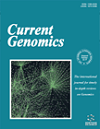- Home
- A-Z Publications
- Current Genomics
- Previous Issues
- Volume 2, Issue 1, 2001
Current Genomics - Volume 2, Issue 1, 2001
Volume 2, Issue 1, 2001
-
-
The Mouse In Cancer Research Past, Present, Future
More LessThe mouse has long been an important component of cancer research. From the realization by Little and Bagg early days of the past century demonstrating a heritable component of sponanteous cancer to the oncogenic manipulations of the germline today, the mouse has been and will continue to be the major mammalian in vivo system to study neoplasic transformation and progression. Use of the mouse has pervaded Read More
-
-
-
Expanding our Understanding of Polyglutamine Disease Through Transgenic Mice
More LessAuthors: J.D. Davidson and H.T. OrrKnowing the mutational basis of a disease does not always explain the mechanism of pathogenesis, particularly when little is known about the disease-associated proteins themselves. This is very likely to be an ever-growing problem in the genomics era. The polyglutamine (polyQ) repeat disorders are an intriguing example of such a scientific dilemma. These human diseases presently include the spinocerebellar ataxia typ Read More
-
-
-
Social Behavior as an Endophenotype for Psychiatric Disorders Development of Mouse Models
More LessAuthors: D. Hranilovic and M. BucanA search for susceptibility genes for psychiatric illness may benefit from recent advances in mouse molecular genetics. Molecular and phenotypic characterization of single gene mutations in mice with anomalies in neurophysiological or neurodevelopmental processes, disrupted in a psychiatric disease, can reveal new insights into the pathways that underlie these genetically complex illnesses. However, in the case of many psyc Read More
-
-
-
Mouse Models of Human Hearing Disorders
More LessBy K.R. JohnsonImpairment of hearing is the most common sensory deficit in human populations. Most cases of human deafness are hereditary. Mutations in many different genes can affect the complex process of hearing. The mouse is an excellent model for studies of these hearing disorders because the anatomy, function, and hereditary abnormalities of the ear have been shown to be similar in both humans and mice. More than 100 spo Read More
-
-
-
Genes Underlying Monogenic and Multigenic Epilepsies in Mice
More LessBy V.A. LettsEpilepsies are defined as a group of disorders with recurrent seizures. It is now well-established from human studies that a good proportion of these epilepsies are inherited. The same finding is true for mice as there are several examples of mouse models showing monogenic and multigenic inheritance of epilepsy. This article reviews the recent developments in mouse positional cloning leading to the identification of many epi Read More
-
Volumes & issues
-
Volume 26 (2025)
-
Volume 25 (2024)
-
Volume 24 (2023)
-
Volume 23 (2022)
-
Volume 22 (2021)
-
Volume 21 (2020)
-
Volume 20 (2019)
-
Volume 19 (2018)
-
Volume 18 (2017)
-
Volume 17 (2016)
-
Volume 16 (2015)
-
Volume 15 (2014)
-
Volume 14 (2013)
-
Volume 13 (2012)
-
Volume 12 (2011)
-
Volume 11 (2010)
-
Volume 10 (2009)
-
Volume 9 (2008)
-
Volume 8 (2007)
-
Volume 7 (2006)
-
Volume 6 (2005)
-
Volume 5 (2004)
-
Volume 4 (2003)
-
Volume 3 (2002)
-
Volume 2 (2001)
-
Volume 1 (2000)
Most Read This Month
Article
content/journals/cg
Journal
10
5
false
en


